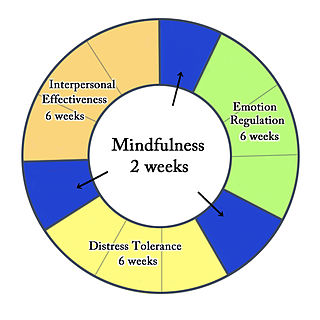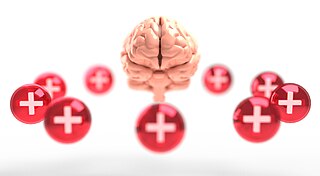
Cognitive behavioral therapy (CBT) is a psycho-social intervention that aims to improve mental health. CBT focuses on challenging and changing unhelpful cognitive distortions and behaviors, improving emotional regulation, and the development of personal coping strategies that target solving current problems. Originally, it was designed to treat depression, but its uses have been expanded to include treatment of a number of mental health conditions, including anxiety. CBT includes a number of cognitive or behavior psychotherapies that treat defined psychopathologies using evidence-based techniques and strategies.

The biopsychosocial model is an interdisciplinary model that looks at the interconnection between biology, psychology, and socio-environmental factors. The model specifically examines how these aspects play a role in topics ranging from health and disease models to human development. This model was developed by George L. Engel in 1977 and is the first of its kind to employ this type of multifaceted thinking. The Biopsychosocial Model has received criticism about its limitations, but continues to carry influence in the fields of psychology, health, medicine, and human development.

Dialectical behavior therapy (DBT) is an evidence-based psychotherapy that began with efforts to treat borderline personality disorder. There is evidence that DBT can be useful in treating mood disorders, suicidal ideation, and for change in behavioral patterns such as self-harm, and substance abuse. DBT evolved into a process in which the therapist and client work with acceptance and change-oriented strategies, and ultimately balance and synthesize them, in a manner comparable to the philosophical dialectical process of hypothesis and antithesis, followed by synthesis.
Perfectionism, in psychology, is a broad personality style characterized by a person's concern with striving for flawlessness and perfection and is accompanied by critical self-evaluations and concerns regarding others' evaluations. It is best conceptualized as a multidimensional and multilayered personality characteristic, and initially some psychologists thought that there are many positive and negative aspects. Perfectionism drives people to be concerned with achieving unattainable ideals or unrealistic goals, often leading to many forms of adjustment problems such as depression, low self-esteem, suicidal thoughts and tendencies and a host of other psychological, physical, relationship, and achievement problems in children, adolescents, and adults. Recent data show that perfectionistic tendencies are on the rise among recent generations of young people.

Mental health is the level of psychological well-being or an absence of mental illness. It is the state of someone who is "functioning at a satisfactory level of emotional and behavioral adjustment". From the perspectives of positive psychology or of holism, mental health may include an individual's ability to enjoy life and to create a balance between life activities and efforts to achieve psychological resilience. According to the World Health Organization (WHO), mental health includes "subjective well-being, perceived self-efficacy, autonomy, competence, inter-generational dependence, and self-actualization of one's intellectual and emotional potential, among others". The WHO further states that the well-being of an individual is encompassed in the realization of their abilities, coping with normal stresses of life, productive work, and contribution to their community. Cultural differences, subjective assessments, and competing professional theories all affect how one defines "mental health".

Social support is the perception and actuality that one is cared for, has assistance available from other people, and most popularly, that one is part of a supportive social network. These supportive resources can be emotional, informational, or companionship ; tangible or intangible. Social support can be measured as the perception that one has assistance available, the actual received assistance, or the degree to which a person is integrated in a social network. Support can come from many sources, such as family, friends, pets, neighbors, coworkers, organizations, etc.

Suicide prevention is a collection of efforts to reduce the risk of suicide. These efforts may occur at the individual, relationship, community, and society level. Suicide is often preventable.
Suicide intervention is a direct effort to prevent a person or persons from attempting to take their own life or lives intentionally.

Suicidal ideation, also known as suicidal thoughts, is thinking about, considering, or planning suicide. The range of suicidal ideation varies from fleeting thoughts, to extensive thoughts, to detailed planning.
Suicide risk assessment is a process of estimating the likelihood for a person to attempt or die by suicide. The goal of a thorough risk assessment is to learn about the circumstances of an individual person with regard to suicide, including warning signs, risk factors, and protective factors. Risk for suicide is re-evaluated throughout the course of care to assess the patient's response to personal situational changes and clinical interventions. Accurate and defensible risk assessment requires a clinician to integrate a clinical judgment with the latest evidence-based practice, although accurate prediction of low base rate events, such as suicide, is inherently difficult and prone to false positives.
Psycho-oncology is an interdisciplinary field at the intersection of physical, psychological, social, and behavioral aspects of the cancer experience for both patients and caregivers. Also known as Psychiatric Oncology or Psychosocial Oncology, researchers and practitioners in the field are concerned with aspects of individuals' experience with cancer beyond medical treatment, and across the cancer trajectory, including at diagnosis, during treatment, transitioning to and throughout survivorship, and approaching the end-of-life. Founded by Jimmie Holland in 1977 via the incorporation of a psychiatric service within the Memorial Sloan Kettering Cancer Center in New York, the field has expanded drastically since and is now universally recognized as an integral component of quality cancer care. Cancer centers in major academic medical centers across the country now uniformly incorporate a psycho-oncology service into their clinical care, and provide infrastructure to support research efforts to advance knowledge in the field.
Occupational rehabilitation is the science and practices of returning injured workers to a level of daily work activities that is appropriate to their functional and cognitive capacity related to their position of which may be influenced by the severity of a worker's injuries.

Suicide is the act of intentionally causing one's own death. Mental disorders—including depression, bipolar disorder, autism, schizophrenia, personality disorders, anxiety disorders, physical disorders such as chronic fatigue syndrome, and substance abuse—including alcoholism and the use of and withdrawal from benzodiazepines—are risk factors. Some suicides are impulsive acts due to stress, relationship problems, or harrassment/bullying. Those who have previously attempted suicide are at a higher risk for future attempts. Effective suicide prevention efforts include limiting access to methods of suicide—such as firearms, drugs, and poisons; treating mental disorders and substance misuse; careful media reporting about suicide; and improving economic conditions. Even though crisis hotlines are common, they have not been well studied.

Norman Louis Farberow was an American psychologist, and one of the founding fathers of modern suicidology. He was among the three founders in 1958 of the Los Angeles Suicide Prevention Center, which became a base of research into the causes and prevention of suicide.

Well-being, wellbeing, or wellness is the condition of an individual or group. A higher level of well-being means that in some sense the individual's or group's condition is more positive. According to Naci and Ioannidis, "Wellness refers to diverse and interconnected dimensions of physical, mental, and social well-being that extend beyond the traditional definition of health. It includes choices and activities aimed at achieving physical vitality, mental alacrity, social satisfaction, a sense of accomplishment, and personal fulfillment".
Pediatric psychology is a multidisciplinary field of both scientific research and clinical practice which attempts to address the psychological aspects of illness, injury, and the promotion of health behaviors in children, adolescents, and families in a pediatric health setting. Psychological issues are addressed in a developmental framework and emphasize the dynamic relationships which exist between children, their families, and the health delivery system as a whole.
The interpersonal theory of suicide attempts to explain why individuals engage in suicidal behavior and to identify individuals who are at risk. It was developed by Thomas Joiner and is outlined in Why People Die By Suicide. The theory consists of three components that together lead to suicide attempts. According to the theory, the simultaneous presence of thwarted belongingness and perceived burdensomeness produce the desire for suicide. While the desire for suicide is necessary, it alone will not result in death by suicide. Rather, Joiner asserts that one must also have acquired capability to overcome one's natural fear of death.
In colleges and universities in the United States, suicide is one of the most common causes of death among students. Approximately 1100 college students commit suicide each year, making it the second-leading cause of death among college students. Roughly 12% of college students report the occurrence of suicide ideation during their four years in school, with 2.6% percent reporting persistent suicide ideation. 65% of college students reported that they knew someone who has either attempted or committed suicide, showing that students on college campuses are likely to be exposed to suicide or suicidal attempts in some form.

Suicide awareness is a proactive effort to raise awareness around suicidal behaviors. It is focused on reducing social stigmas and ambiguity, by bringing attention to suicide statistically and sociologically, and encouraging positive dialogue and engagement as a means to prevent suicide. Suicide awareness is linked to suicide prevention as both address suicide education and the dissemination of information to ultimately decrease the rate of suicide. Awareness is a first stage that can ease the need for prevention. Awareness signifies a fundamental consciousness of the threat, while prevention focuses on stopping the act. Suicide awareness is not a medical engagement, but a combination of medical, social, emotional and financial counseling. Suicide awareness in adolescents focuses on the age group between 10–24 years, beginning with the onset of puberty.

The COVID-19 pandemic has impacted the mental health of people around the world. The Guidelines on Mental Health and Psychosocial Support of the Inter-Agency Standing Committee of the United Nations recommends that the core principles of mental health support during an emergency are "do no harm, promote human rights and equality, use participatory approaches, build on existing resources and capacities, adopt multi-layered interventions and work with integrated support systems." COVID-19 is affecting people's social connectedness, their trust in people and institutions, their jobs and incomes, as well as imposing a huge toll in terms of anxiety and worry. COVID-19 also adds to the complexity of substance use disorders (SUDs) as it disproportionately affects people with SUD due to accumulated social, economic, and health inequities. The health consequences of SUDs and the associated environmental challenges increase risk for COVID-19. COVID-19 public health mitigation measures can exacerbate loneliness, mental health symptoms, withdrawal symptoms and psychological trauma. Confinement rules, unemployment and fiscal austerity measures during and following the pandemic period can affect the illicit drug market and drug use patterns.











